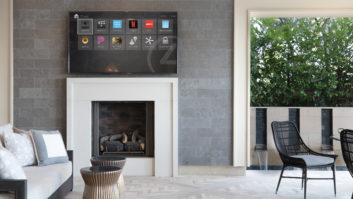The numbers of people working from home have risen steadily over the past few years, and don’t show signs of slowing down. Adrian Ickeringill, Modular sales manager for Armour Home, says that the increasing need to equip homes with the appropriate technology for home working provides advantages for developers as well as for the home owner.
Twenty years ago, ‘working from home’ was more a phrase akin to taking the day off than to actually working in your home environment. Even if you genuinely did want to work from home for one day, you were very limited in what you could do and pretty isolated. Now, the phrase ‘working from home’ means just that and more and more of us are doing it. In fact, I’m doing it right now writing this very article.
Home working has only been made possible for the vast majority of professionals through technology – which home workers have quite literally at their fingertips. We think nothing of having a second line for work-related telephone/fax; we have a mobile phone that people can reach us on 24/7; we have laptops and desk computers with high-speed broadband connections allowing us to email, telephone, video conference, download information, send work, researchÖ and the list goes on. Our expectations have changed: we expect to be able to do most of the things that we do in an office at home. And my goodness, don’t we get irritable if we have to wait just that bit longer to download a document than we would in the office.
Being able to provide this revolutionary technology in one ‘clean’ package is the way ahead – the way to meet the increasing demand for working from home. For the housing developer it adds value to a property for a relatively small investment; plus, under the UK’s Code for Sustainable Homes, 1.2 points are awarded for ‘the provision of a space and services which allows the occupants to set up a home office in a quiet room’. The developer can in turn promote the facilities as part of a sustainable home and one that will support known technology advances into the future. The other advantage is in the new- build-versus-existing-property argument, as only new properties would be able to provide such sophisticated features: to fit an existing property with such services generally means a lot of disruption to install the cabling.
The conventional way to bring such technology into the home and distribute it around the property is by cabling for TV and satellite to the loft and running telephone cable to limited points (normally the lounge and an upstairs bedroom); usually there is no incremental cabling for data points. This approach assumes the homebuyer will go down the route of wireless technology, such as with DECT phones, but there are some very real problems with this, primarily with issues of signal strength and interference from other properties or devices in the home such as microwaves.
However, there is another option and one that avoids the wireless signal problems. The new solution is to adopt a system that can take all the external feeds – such as broadband, satellite and so on – and distribute them around the home efficiently, cost-effectively and reliably via cabling installed into the very fabric of the building. By providing a central hub for home networking, the developer is providing an infrastructure that enables full flexibility in the home. Armour Home offers such a solution in the form of its Homenet system.
Part of the best-selling Systemline Modular built-in home entertainment system, Systemline HomeNet is a range of enclosures that provide the gateway to home automation. HomeNet enclosures act as a central hub from which all incoming services – including telecommunications, data, radio, CCTV, terrestrial, satellite and cable TV and Systemline Modular multiroom entertainment – are distributed around the home via Cat5 and coaxial cables. It allows for a wide range of services to be brought into the home conveniently, cost-effectively and neatly.
Essentially, adopting such an approach provides a backbone structure from where you can readily adapt and upgrade services, such as adding extra phone lines into different rooms. Of course, if you still want to use wireless products, the system will also allow for this (the Homenet system is available with wireless routers and antenna to assist in providing a quality wireless signal).
With the tough economic climate – one that is affecting professionals from all walks of life – the ability to work from home, with all the services you need at your fingertips, is very appealing. Being able to provide this in a property will only become more important and gives the developer an edge over competitors both in the resale market and those new build-developers who aren’t quick to see the benefits. We see it as the ‘fourth utility’ – it’s that essential.







